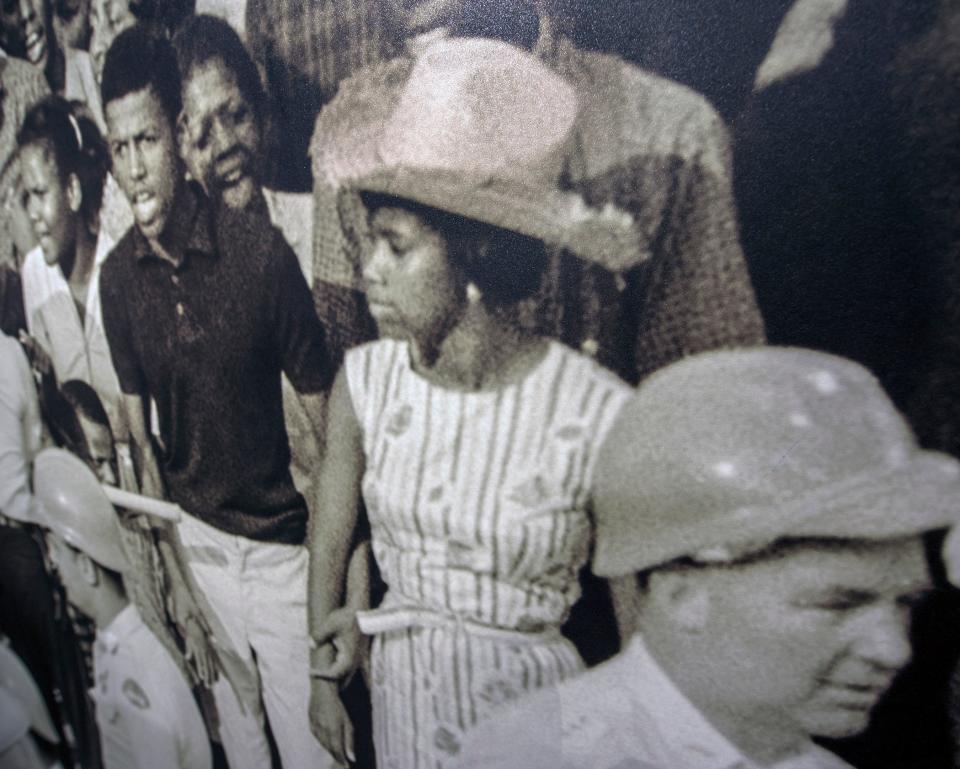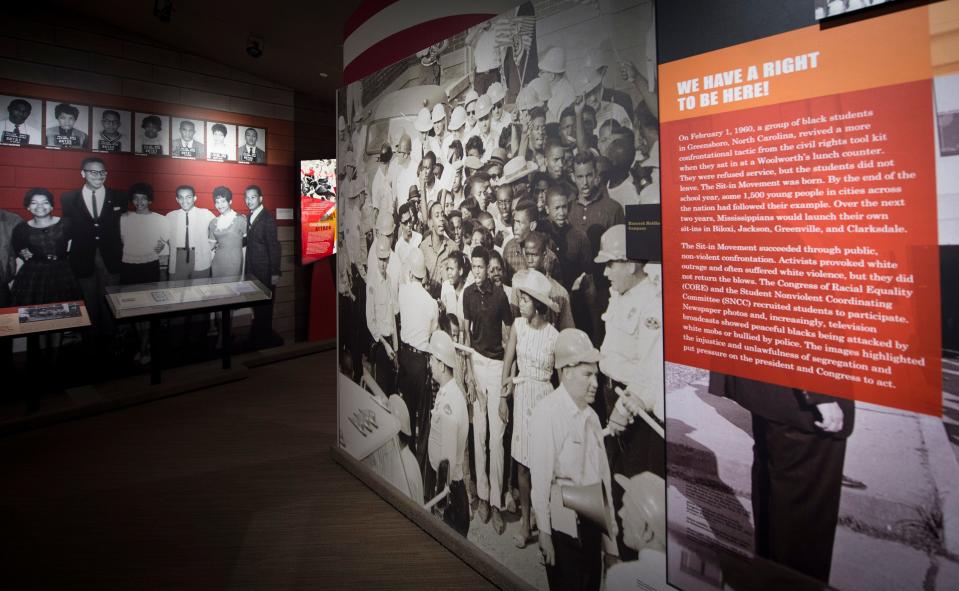'I just had to cry': Woman discovers sister's photo in Mississippi Civil Rights Museum
JACKSON, Miss. – In 1963, the year before Freedom Summer, Dorothy Pitchford was late coming home from her Jackson school one day. Over 1,000 miles away, in Chicago, her aunt was watching the national nightly news. Suddenly, Pitchford was on screen, being loaded into the back of a "paddy wagon."
The 16-year-old had been arrested with a group of people who had protested on Capitol Street in Jackson that afternoon. She hadn't told any family members she was going; their mother dissuaded them from what she thought could be trouble.
Pitchford's aunt called the teen's father, Winster Pitchford, telling him, "I think Dorothy has been arrested."
Her older brother, Joe Pitchford, was sent to go get her. The group was being held next to the coliseum and, because their father was a railroad man and well known in town, Dorothy Pitchford was released, Joe Pitchford said.
"They didn't cause me any problems, they just let me have her," he said.
Over the years, the story of Dorothy's arrest would be told, passed down from generation to generation, said her younger sister, Edith Pitchford.
The family continued to share the story after Dorothy's death but there wasn't any photographic proof. They had to rely solely on their own memories from what happened that day over 50 years ago.
Or so they thought.

'I didn't want her to do it'
After it opened, Edith Pitchford, 65, and a friend went to visit the Mississippi Civil Rights Museum. In gallery six, across from jail cell bars, stood a large black and white photo. Immediately, Edith saw her sister.
Toward the front of the photo, wearing a knee-length dress and hat, Dorothy Pitchford was walking down Capitol Street. The man next to her, also a young African American, had his fingers encircled around Dorothy's wrist.
Her face was turned toward the right, away from the white police office standing feet away in a helmet. The group is surrounded by white men in hard hats, with some holding batons. Another holds a bullhorn.
"That's my sister," Edith exclaimed, and the tears started to flow.
"I just had to cry, she said. "With her being deceased, I would say that's just a great tribute to Dorothy, that she worked so hard."
Edith, Joe and Lela Pitchford spoke from their home in Terry. Describing their sister, they would often burst into laughter. The mood would then turn somber as they recounted the lives they lived over 50 years ago.
Dorothy attended Jim Hill High School in Jackson but, as policy back then, was sent to a different school, Lanier High School, when she became pregnant. That's where she met the Freedom Riders, Edith said.
"By her going to Lanier, the Freedom Riders told them, 'If you participate, with you all being minors, you won't be arrested.'"
Their mother, Lela Pitchford, 97, was the granddaughter of a man who had once been a slave. When the children were growing up, Lela taught them not to look a white person in the eye, Edith said. During the civil rights movement, she told her children not to get involved, for fear of what might happen to them.
"Dorothy was smart, a good girl," Lela Pitchford said. "I didn't want her (to go). At that time, my children were small and I didn't want no problems. During them times, white people would take you out in the woods and kill you...I didn't want her to do it."
Reflecting back, a 77-year-old Joe Pitchford credits his mother with keeping them safe.
"It was something with all these different water fountains, places to go to the bathroom," he said. "But for some reason, out family never got into really bad stuff down there. We knew where the ins and outs was and we tried to stay away from that. She kept us out of most trouble."
But for Dorothy, not going wasn't an option, Edith said.
"Dorothy was an exceptional person by doing the things she did, by going to Lanier and taking a chance to go downtown and get beat by being in that situation...she was going to do her part," she said.
Lela Pitchford added, "I don't think she really thought nothing about it. She just wanted to do something. Dorothy believed in being right."
Dorothy died in Jackson in 2016 of kidney failure. She was 69.

'These are actual people'
Since its 2017 opening, several families have come through the museum and recognized family members, said Joyce Dixon-Lawson, museum curator of research and genealogy.
"We always think of history as something that was 100 years ago," she said. "This is history but this is recent history. A lot of these people are still alive and you can go back and see these photographs and actually talk to the relatives and say, 'What were you doing? What were you motives behind it?' and just to see how people fought in the struggle. You always hear about the civil rights movement but, other than what you see in the movie, what do you know about it?"
Offering an example, Dixon-Lawson pointed to a photo of an older woman who was fighting for the right to vote. The woman was unidentified but then a man visiting the museum said "that's my grandma."
"We didn't know who she was," Dixon-Lawson said, but family identified her as Georgia Seaton. One by one, they all came to the museum to see the photo. Seaton's daughter-in-law came to museum, looked at that specific photo, took a picture of it and left.
"That was all she wanted to see, was just this one photograph," Dixon-Lawson said.
There was the man who was the lone unidentified person in a photo with Dr. Martin Luther King. A man walking through said "that's my uncle." Dixon-Lawson is trying to track down the man's family.
In another visit, a man saw a picture of his grandfather – that had long been in a family Bible – hanging on the museum's walls. The museum had acquired a copy from the Works Progress Administration, a back-to-work program from the Great Depression.
"His picture is everywhere," Dixon-Lawson said. "(The man) was just amazed."
On the walls of the museum, there are copies of live sketches a New York Times illustrator drew in the field during Freedom Summer while he followed Fannie Lou Hamer. On one wall, there's a little girl sitting in a rocking chair. Across the way, there's a woman talking to two people about voter registration, a child beside her.
A woman visiting the museum said that was her as a little girl, her mother and younger brother. Her mother is deceased but she took a photo to show family members.
"It adds a humanist piece to it," Dixon-Lawson said. "You can see pictures and you don't know who they are but when someone comes in and they start telling the story it really makes you realize, these are not just sketches, these are actual people."
When visitors recognize family in museum photos, Dixon-Lawson makes a point to come and talk to them and to find out who the person was behind the photo.
"It always makes me feel good when people come in and say, 'This is my family'," she said. "Most of the people are deceased and to hear the pride in their voice when they say 'This is my relative right here,' it does something to me."
The museum has a list of names of people, like Dorothy Pitchford, that have been identified since the opening. They hope to be able to go back and add names to the photos, Dixon-Lawson said, but that's a "long-term" project.
More in Mississippi: Alligator spotted in Mississippi floodwaters as Hurricane Barry nears
A closer look: History of civil rights progress reveals flawed, ambitious men with noble aims
Dorothy's memory
The Pitchford family had a saying: "You gonna get your books." No one pushed the siblings to get their education more than Dorothy, Edith said. Out of six siblings, five attended college. Dorothy was forced to get married and, instead of attending college, became a homemaker and had two children, Adlene Collins-French and Lisa Collins.
"She felt like she kind of messed up by getting pregnant before she graduated but she still made sure everybody else was doing what they should do," Edith said. "She always wanted the best (for us.)
Edith graduated high school and Jackson State University before joining the National Guard and later becoming a public school teacher. Dorothy was a large part of that, she said.
"For me, it's like an indelible mark. I stand this short, or this tall, because of her."
Dorothy's family wants people to know that she was "creative, smart, very funny" and "loved everybody." But, mostly, they want visitors to the civil rights museum to know the name of the woman in the photo.
"She has a family that loved and cared about her and she took a stand for African Americans to get the right to vote," Edith said.
Follow Sarah Fowler on Twitter: @FowlerSarah.
This article originally appeared on Mississippi Clarion Ledger: Woman identified in photo at Mississippi Civil Rights Museum

